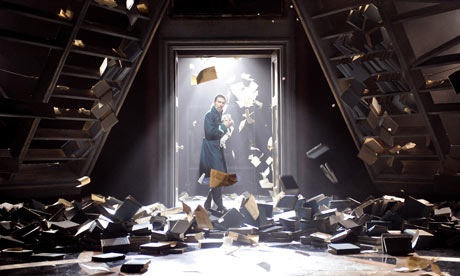Oops... If you’re reading this now, you probably are giving me a scowl of disapprobation as I belatedly return to my much-neglected blog. Ah well, I rest easy knowing that there are probably only a few of you (Hi Mom and Dad!) that actually look for updates on this sucker, and the rest of you have probably happily forgotten all about my semester abroad.
Indeed, I almost have as well! I’ve been home for three days now, settling easily back into Williamstown life – frigid temperatures, long hours on the couch, and running into old friends at the coffee shop. And yet, though London feels thousands of miles away now (and I suppose it is…), I doubt that I will ever fully leave the past semester behind. It was an incredible experience for me, and I grew both as a person, learning to live in a city and to find my way in a world populated with unfamiliar people, and as an actor and viewer of theatre. The time I spent at BADA is unlike anything I have ever done before, and I am so grateful to have come here.
I imagine that this is my last post, since this blog was designed solely for the purpose of keeping my friends and family updated on my exploits abroad, both in Italy this summer and in London this semester. And what would one of my posts be if it were not overly long and filled with bullet points in a feeble attempt to organize what I have to say into something readable? In that spirit, then, here is a quick overview of my semester since last I posted:
I left off at the end of the first half of the semester, which is where I ended my classes. After a hectic final week involving paper writing and the final performance of Vanbrugh’s The Relapse for High Comedy, my dear friends Ashley, Meghan, Katie, Rachel, and I caught a plane (from the always questionable EasyJet fleet) to…
Greece! We spent three incredible days in Athens, staying in the sketchy but cheap Onomia district. One of our very first stops, naturally, was the Acropolis, which was absolutely amazing, especially for someone as tragically enamored with Classics as I. Standing in front of the Parthenon actually brought tears to my eyes, much to my embarrassment. Other highlights included the Acropolis Museum, the National Archaeological Museum, the Agora, and summiting Lycabettus Hill for spectacular nighttime panoramas of the city. Pictures at: http://picasaweb.google.com/isaisastc/AthensForPicasa#
After Greece, we began a breakneck journey through Italy. For the next four days, we visited Rome, Florence, Bologna, and Pisa. It was a little mad, but fun all the same. Rome was the top for me; only there could I just happen upon the Pope giving Mass in St. Peter’s Square. It was an incredible experience to see hundreds of people all gathered for the same thing, all part of something that means so much to them. But even better was my long-awaited venture to the Villa Giulia Museum of Etruscan Art. I went by myself on a sort of pilgrimage to this museum that I keep missing every time I’m in Rome, and it lived up to all my expectations. The stars of the museum are the Sarcofago degli Sposi (the Sarcophagus of the Spouses), excavated at Cerveteri, the famed Apollo of Veii and its companion acroterial statues, and the East pediment of Temple A at Pyrgi, which depicts an episode from the story of the Seven against Thebes wherein Tydeus gnaws on the head of Melanippos.
After Rome we jaunted off to Florence, where I did some more museum-ing, including the Bargello Gallery and the Museo di San Marco. The latter is a fascinating museum, consisting mainly of an old monastery whose cells were painted by Fra Angelico. The contrast between his vibrant, though tiny frescoes and the surrounding austerity was fascinating. Our next city was Bologna, where we took a break from our museum adventures to climb the Tower and relax for a day. Then it was off to Pisa, where we stayed in a beautiful B&B, then hit up the Piazza della Miracoli in the morning before our flight home! Pictures from all of Italy at: http://picasaweb.google.com/isaisastc/ItalyBADAForPicasa#
The rest of my semester was devoted to Measure for Measure, the production I ended up being cast in, directed by the renowned David Freeman. He had a great spin on the play, and interpreted it through the lens of Philip Zimbardo’s Stanford Prison Experiment. It is amazing how well the two actually mesh – looking at them together really heightens our awareness of the spectre of power in Shakespeare’s text and the way it corrupts, distorts, and destroys. Because Measure for Measure is a comedy, it is easy to forget the magnitude of losing one’s head. But that’s what the play is about – torture, both psychological and physical, execution, and deceit. Our production really played up the dark side of this comedy, but that actually allowed the humor in it to glow ever brighter (at least, I hope!). My role in the show was Pompey, the clown. Not having played many humorous roles in my time, it was a stretch for me, but I think I learned a lot from it and it took me to some wonderfully surprising places. Plus, I got to wear a padded bum in the end, and what more can one ask from theatre? Pictures at: http://picasaweb.google.com/isaisastc/MeasureForMeasureForPicasa#
Other adventures included a master class with the illustrious Fiona Shaw, a trip to Surrey and Hampton Court Palace, and week with my parents in London. Pictures at: http://picasaweb.google.com/isaisastc/SecondHalfOfTheSemesterForPicasa#
All my public photos are at: http://picasaweb.google.com/isaisastc






